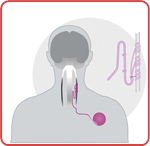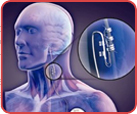| Vagus Nerve Stimulation |
 |
 |
|
 |
Vagus nerve stimulation therapy is another form of treatment that should be tried when medications fail to stop seizures. It is currently approved for use in adults and children over the age of 12 who have partial seizures that resist control by other methods. The therapy is designed to prevent seizures by sending regular small pulses of electrical energy to the brain via the vagus nerve, a large nerve in the neck. |
 |
 |
 |
Vagus nerve stimulation (VNS) in humans refers generally to stimulation of the left vagus nerve at the cervical level using the NeuroCybernetic Prosthesis (NCP, Cyberonics, Inc.) system . This equipment consists basically of three parts: 1) the implantable, multiprogrammable bipolar NCP pulse generator, which is similar to a cardiac pacemaker in size and shape; 2) two helical electrodes, which are wrapped around the vagus nerve and are linked to the pulse generator by a bipolar lead; and 3) a programming wand linked to a computer running programming software,
which allows noninvasive programming, functional assessment (device diagnostics), and data retrieval. |
|
 The pulse generator is implanted in a subcutaneous pocket in the left chest wall, whereas the electrodes are attached to the vagus nerve, made accessible by an incision in the neck. Through a subcutaneous tunnel, the electrodes are linked to the pulse generator. The system delivers electrical impulses at frequencies between 1 and 30 Hz, at 0.25 to 3.5 mA, with a pulse width varying from 130 to 1000 microseconds at variable on-off times. The pulse generator is implanted in a subcutaneous pocket in the left chest wall, whereas the electrodes are attached to the vagus nerve, made accessible by an incision in the neck. Through a subcutaneous tunnel, the electrodes are linked to the pulse generator. The system delivers electrical impulses at frequencies between 1 and 30 Hz, at 0.25 to 3.5 mA, with a pulse width varying from 130 to 1000 microseconds at variable on-off times.
|
 |
 |
 |
|
be able to take less medication than in the past.
The VNS system was approved for people with partial onset seizures -- seizures that begin in one part of the brain. It is intended for people whose seizures do not respond to medications . |
 |
Also, they must not have any other medical conditions that might be affected by the device. For example, VNS should not be used in people who have had certain other throat operations or disorders affecting the throat. |
 |
Implanting the VNS battery in a patient and connecting it to the vagus nerve takes about an hour. It is usually done under general anesthesia, though local anesthesia is sometimes used. |
 |
The surgeon makes two small incisions -- one in the neck to gain access to the vagus nerve, and one below the collarbone in the chest wall or armpit. |
 |
The surgeon places the VNS pulse generator into a surgically-made "pocket" under the skin of the patient's chest and threads a plastic tube containing the electrodes from the neck to the generator in the chest. He or she then gently wraps the flexible ends of silicone-coated electrodes around the vagus nerve. |
 |
 |
 |
Programming the Device |
 |
 |
 |
Some doctors turn on the VNS device immediately after surgery. Others prefer to start the stimulation during the check up visit afterwards. Doctors program the device to deliver pulses of electrical stimulation automatically, 24 hours a day. |
 |
A typical "dose" is about 30 seconds on and five minutes off, but settings may vary. The device continues the cycle until the neurologist re-programs it or until the battery runs out -- usually in about six years. At that time another surgical procedure (which only involves the chest) can be done to replace the battery, usually with a local anesthetic. |
|
|
 |
 |
 |
Response to Therapy |
 |
It's hard to know in advance how someone with epilepsy will respond to VNS therapy.
Successful VNS therapy reduces the number of seizures people have and, sometimes, how long they last. It's unlikely to stop seizures completely.
Even when people respond well, improvement usually takes time. It isn't likely to happen immediately after the doctor implants the device. Several months may go by before there's any change, followed by a slow but steady improvement.
However, seizure control is not the whole story for this type of treatment. For reasons that are still not well understood, VNS therapy appears to have some other effects as well.
Studies find that many people who have had the implant say they feel better, even if their seizures continue. They say they feel better after a seizure, are in a better mood, feel more alert, have better memory and fewer emergency room visits |
 |
 |
 |
Monitoring the Implant |
 |
After surgery, and after the VNS device has been programmed, the doctor schedules a series of follow-up visits. During office visits, the doctor checks the VNS system to make sure it is working properly and that the treatment is not uncomfortable. Most common side effects are hoarseness, cough, tickling in the throat, and changes in voice tone during actual stimulation. |
 |
 |
 |
| VNS Stimulation is Adjustable |
 |
|
 |
Sometimes people worry that the device may be rejected by the body. Fortunately, rejection is not a problem because the VNS device is made of titanium, a material that is widely used for pacemakers and does not trigger an immune response. Vagus nerve stimulation is an effective, safe, and well-tolerated treatment in patients with long-standing, refractory partial-onset seizures, and may also be beneficial in other types of seizure. Problems arising during the implantation procedure are rare and manageable. |
 |
 |
 |
|